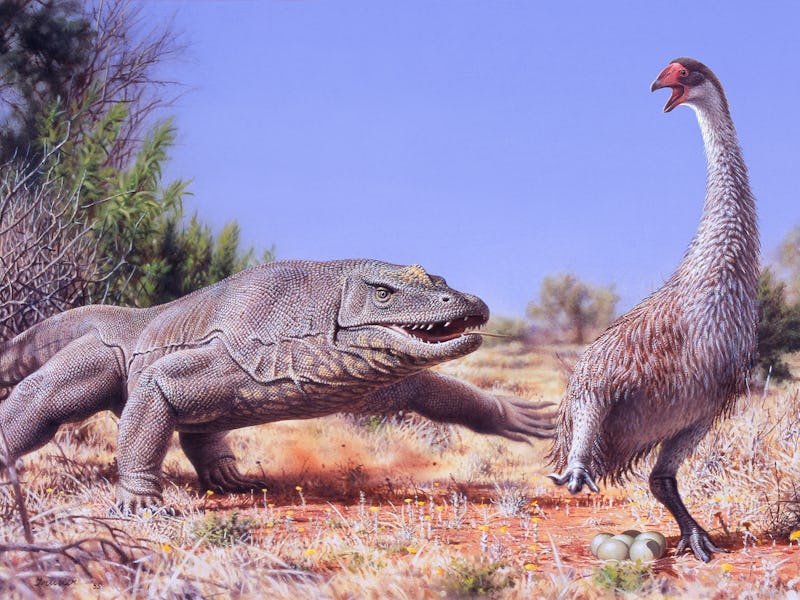Humans Probably Ate this 500-Pound Bird to Extinction in Australia
People are the worst.

Meet Genyornis newtoni, the dinosaur-like bird that roamed Australia until about 47,000 years ago. The flightless avian species weighed an impressive 500 pounds and measured seven feet tall. But a new theory proposes that they were no match for hungry humans.
Two new studies, published this week in Nature Communications have added new weight to the theory that human predation tipped the scales against the Genyornis newtoni and other large animals.
Between 10,000 and 50,000 years ago, widespread extinction of animal species of at least about 100 pounds — known collectively as megafauna — took place. Although scholars have been able to temporarily overlap the introduction of humans to the Australia with the rise in extinction rates, there is a dearth of physical evidence that humans preyed on these large animals. As a result, some researchers continue to argue that climatic change is the likely culprit.
A pencil drawing of *Genyornis newtoni*, a thunderbird from the pleistocene of Australia.
But those birds were laying delicious, nutritious, 3.5-pound eggs, that presumably were just sitting around the Australian Outback. That’s the equivalent of more than two dozen chicken eggs, and provided about 2,000 calories of energy. Score!
In one study, authors describe eggshell fragments from these beasts at more than 200 sites around Australia, and they showed burn patterns that are inconsistent with wildfire. Instead, there was on some a gradated burn pattern, as if the shells had been scattered near a campfire, with one edge charring and the other staying mostly unburnt.
Irregular burn patterns on eggshell fragments could not have been caused by wildfire.
“These characteristics are most consistent with humans harvesting one or more eggs from a nest, making a fire and presumably cooking the egg,” the authors write. “For the same reason that it is possible to boil water in a paper cup over a fire without burning the cup, cooking an egg in a manner that does not cause the egg to explode, will not char the eggshell.”
Similar burn patterns appear on emu eggs dating back to the same era, and can be found today.
Records of traditional Aboriginal cooking of emu eggs describe a relatively slow cooking of the eggs, either wrapped in vegetation or in hot ashes in a hole dug in the ground for that purpose, from which the egg would be removed and rotated or shaken frequently, then repositioned, according to the article.
The timeframe where the burning of the eggs would have occurred correlates both with the dispersal of humans across the Australian continent and the gradual extinction of Genyornis newtoni.
The second study, with some of the same authors, worked from the opposite angle, bringing weight to the position that climatic changes did not cause megafaunal extinctions in Australia.
The authors also show that periods of climatic change don’t match periods of higher extinction rates, when they used updated technologies to date the fossil record. They also show that humans and megafauna overlapped on the continent for about 13,500 years, which would have been long enough for predation pressure to make an impact on the ability of megafauna to survive.
“Quantitative models have demonstrated that even small groups of hunter–gatherers living across a vast continent and using stone-based technologies could feasibly exterminate species with low population growth rates, such as large-bodied mammals,” the authors write.
The studies, taken together, give new strength to the argument that humans have been shaping the landscapes we inhabit in dramatic ways for a very, very long time. Even sparse tribal people with stone tools could be responsible for wiping out a large percentage of the planet’s megafauna. That sort of puts into terrifying perspective the damage that we’re doing to the planet and its inhabitants today.